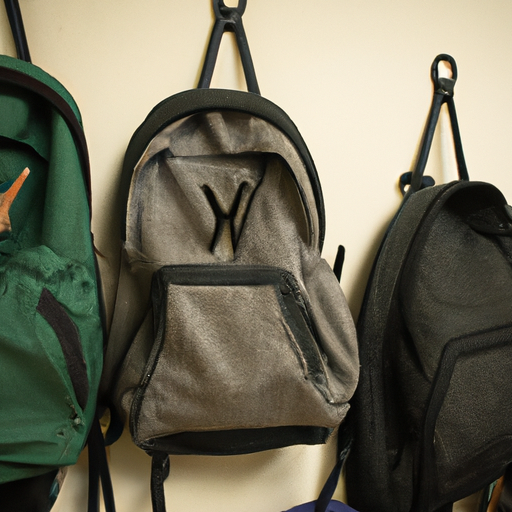How To Store Backpacks
So you’ve finally found the perfect backpack, equipped with all the compartments and durability that you need for your adventures. But now comes the question of how to store it when it’s not in use. We all know the frustration of rummaging through a disheveled pile of backpacks, struggling to find the one we need. In this article, we will explore simple and effective techniques for storing your backpacks, keeping them organized, and ensuring they are ready to go whenever you’re ready for your next escapade. From utilizing wall hooks to creating dedicated storage spaces, we’ll guide you on the path to backpack bliss.
Choosing a Storage Location
Consider Climate and Environmental Conditions
When choosing a storage location for your backpack, it’s important to consider the climate and environmental conditions of the area. Extreme temperatures, high humidity, and exposure to moisture can all have a negative impact on the condition of your backpack. Opt for a storage area that is dry and well-ventilated to prevent the growth of mold and mildew.
Evaluate Available Space
Another factor to consider when choosing a storage location is the amount of available space. A cramped or overcrowded storage area can lead to damage to your backpacks, such as bent frames or torn fabric. Ensure that the storage area you choose can accommodate your backpacks without putting undue pressure on them.
Assess Potential Hazards
Take into account any potential hazards in the storage area that could damage your backpacks. Sharp objects, heavy items, or debris that may come in contact with your backpacks can cause punctures or tears. Look for a storage location that is free from these hazards to ensure the safety and longevity of your backpacks.
Choose a Clean and Dry Area
Lastly, choose a clean and dry area to store your backpacks. Dust, dirt, and other particles can accumulate over time and affect the performance and lifespan of your backpacks. Prioritize a space that is free from any contaminants and regularly clean the area to maintain a clean storage environment.
Preparing the Backpack
Empty and Clean the Backpack
Before storing your backpack, it is important to empty and clean it thoroughly. Remove any items, shake out debris, and wipe down the interior and exterior surfaces. This will help prevent the growth of mold and mildew and ensure that your backpack is ready for storage.
Inspect for Damages
Take the time to carefully inspect your backpack for any damages. Look for signs of wear and tear, such as frayed straps, loose threads, or broken zippers. Repair any minor damages before storing the backpack to prevent them from worsening during storage.
Remove Detachable Parts
If your backpack has detachable parts, such as hip belts or shoulder straps, it is recommended to remove them before storage. Not only does this prevent them from getting tangled or damaged, but it also allows for better airflow inside the backpack.
Loosen Straps and Buckles
To avoid placing unnecessary stress on the straps and buckles, loosen them before storing your backpack. This will help maintain their elasticity and prevent them from becoming stretched or deformed.
Organizing Backpack Contents
Sort Items by Category
When organizing the contents of your backpack, it is helpful to sort items by category. Group together similar items, such as clothing, food, and camping gear. This will make it easier to locate specific items when you retrieve your backpack from storage.
Group Similar-sized Items
When packing your backpack for storage, it is beneficial to group similar-sized items together. This helps to distribute the weight evenly throughout the backpack and prevents any sharp or heavy objects from causing damage to more delicate items.
Use Packing Cubes or Compression Bags
Consider using packing cubes or compression bags to maximize space and keep your backpack organized. These handy storage accessories allow you to neatly pack and compress your belongings, reducing the overall bulk of your backpack.
Separate Fragile or Sharp Objects
To protect fragile or sharp objects, it is recommended to separate them from the rest of your backpack contents. Place them in a padded pouch or wrap them in soft fabric to prevent them from causing damage to other items during storage.
Methods for Hanging Backpacks
Wall-mounted Hooks
Wall-mounted hooks are a convenient option for storing backpacks, especially if you have limited floor space. Install sturdy hooks on a wall to hang your backpacks, allowing for easy access and visibility.
Over-the-Door Hooks
If wall-mounted hooks are not feasible, over-the-door hooks can be a great alternative. These hooks can be easily hung over the top of a door, providing a designated space for your backpacks without taking up valuable floor or wall space.
Closet Rods with Hangers
Utilizing closet rods with hangers is another effective method for hanging backpacks. Simply hang the backpacks from the closet rod using hangers designed for this purpose. This keeps your backpacks neatly hung and easily accessible.
Adhesive Hooks
For a quick and temporary storage solution, adhesive hooks can be used to hang backpacks. These hooks can be easily attached to any smooth surface, such as a wall or door, and provide a simple and efficient way to store your backpacks.
Stacking Backpacks
Avoid Overstacking
When stacking backpacks, it is important to avoid overstacking them. Too much weight can cause the bottom backpacks to become compressed, leading to deformities or damage. Ensure that the stack of backpacks is stable and not overly heavy.
Place Heavier Backpacks at the Bottom
To maintain stability and prevent damage to lighter backpacks, it is advisable to place heavier backpacks at the bottom of the stack. This ensures that the weight is evenly distributed and minimizes the risk of crushing or flattening the backpacks underneath.
Use Shelf Dividers or Bins
To create a well-organized and easily accessible stacked backpack storage system, consider using shelf dividers or bins. These accessories can help compartmentalize the stack, making it easier to retrieve specific backpacks without disturbing the entire stack.
Rotate Stacked Backpacks Periodically
To prevent strain on the straps and frames of stacked backpacks, it is recommended to rotate them periodically. This ensures that no single backpack is continuously supporting the weight of the others, helping to maintain their structural integrity.
Folding and Bagging Backpacks
Fold Backpacks Neatly
When folding your backpacks for storage, take the time to fold them neatly to minimize creases and wrinkles. Follow any specific folding instructions provided with your backpacks, or simply fold them in a way that ensures they fit neatly into the storage space.
Use Storage Bags or Covers
Consider using storage bags or covers to further protect your backpacks during storage. These bags or covers can provide an extra layer of defense against dust, dirt, and potential damage from other items in the storage area.
Remove Excess Air
If using storage bags, it is important to remove excess air before sealing them. This can be done by compressing the bag or using a vacuum sealer. Removing excess air reduces the risk of moisture accumulation and helps to maximize available storage space.
Label or Tag Bags for Easy Identification
To make it easier to locate specific backpacks when needed, label or tag each storage bag or cover. Clearly indicate the contents or owner of the backpack, ensuring that you can quickly identify the desired backpack without needing to open multiple bags.
Protecting Backpacks from Pests
Use Mothballs or Cedar Blocks
To protect your backpacks from pests such as moths or insects, consider using mothballs or cedar blocks. These natural repellents can help deter pests and prevent damage to your backpacks while in storage.
Avoid Storing in Basements or Attics
Basements and attics are prone to higher levels of humidity and temperature fluctuations, making them less ideal for backpack storage. Avoid storing your backpacks in these areas, as the conditions can promote mold growth or damage the integrity of the materials.
Inspect Regularly for Signs of Infestation
Even with precautions, pests can sometimes find their way into your storage area. To catch any potential infestations early, regularly inspect your backpacks for signs of pests, such as holes in the fabric, droppings, or unusual odors.
Consider Pest-repellent Products
If you are concerned about pests invading your backpacks, you may wish to consider using pest-repellent products. There are various options available, such as sachets or sprays specifically designed to deter pests from infesting stored items.
Maintenance Tips for Stored Backpacks
Check and Clean Backpacks Periodically
Even while in storage, it is essential to periodically check and clean your backpacks. Remove them from storage and inspect both the interior and exterior for any signs of damage, mold, or mildew. Clean as necessary and allow them to air dry before returning them to storage.
Keep Backpacks Away from Direct Sunlight
Direct sunlight can cause the colors of your backpacks to fade over time and accelerate the aging of the materials. Whenever possible, store your backpacks away from direct sunlight to maintain their original appearance and prolong their lifespan.
Inspect Zippers, Straps, and Fastenings
Regularly inspect the zippers, straps, and fastenings of your stored backpacks. Look for any signs of wear or damage and address them promptly. Repair or replace any faulty components to ensure that your backpacks remain in good working condition.
Maintain Proper Air Circulation
Proper air circulation is crucial for preventing the growth of mold and mildew. Avoid sealing your backpacks in airtight containers or stuffing them tightly in storage areas. Allow for sufficient airflow to minimize the risk of moisture accumulation.
Long-term Storage
Pack Backpacks in Acid-free Paper
For long-term storage, consider using acid-free paper to pack your backpacks. Acidic materials can deteriorate the fabric and other components of your backpack over time. Acid-free paper provides a protective barrier without causing any damage.
Avoid Plastic Bags for Extended Storage
While plastic bags may seem like a convenient option, they can trap moisture and promote the growth of mold or mildew. Avoid using plastic bags for extended storage of your backpacks, as they do not allow for proper ventilation.
Store in Climate-controlled Environment
To ensure the best possible conditions for your backpacks, store them in a climate-controlled environment. This helps regulate temperature and humidity levels, reducing the risk of damage caused by extreme conditions.
Recheck Backpacks Regularly
Do not forget to recheck your backpacks regularly, even during long-term storage. This allows you to spot any potential issues or damages in a timely manner and take appropriate measures to address them before they worsen.
Retrieving a Backpack from Storage
Remove Backpacks with Care
When retrieving backpacks from storage, handle them with care to avoid unnecessary stress or damage. Gently lift them and avoid dragging them along surfaces that could cause abrasion or snagging.
Inspect for Contaminants or Odors
Before using a backpack that has been in storage, inspect it for any contaminants or unusual odors. Dust or debris may have accumulated, and if there are any mildew or musty smells present, it may indicate mold or mildew growth.
Gently Clean and Air Out if Needed
If your backpack requires cleaning or has picked up any odors while in storage, follow the manufacturer’s instructions for cleaning or gently spot clean as needed. Allow the backpack to air out thoroughly before packing it for use.
Reassemble Detachable Parts
If you had removed any detachable parts before storing your backpack, be sure to reassemble them before using the backpack. Double-check that all straps, buckles, and other components are securely attached and in good working condition.
By following these comprehensive guidelines for storing backpacks, you can ensure that your backpacks remain in excellent condition and are ready for your next adventure. Proper storage practices not only protect the integrity and longevity of your backpacks but also make it easier to locate and retrieve them when needed. With a little organization and care, your backpacks will be ready to accompany you on many more exciting journeys to come.




